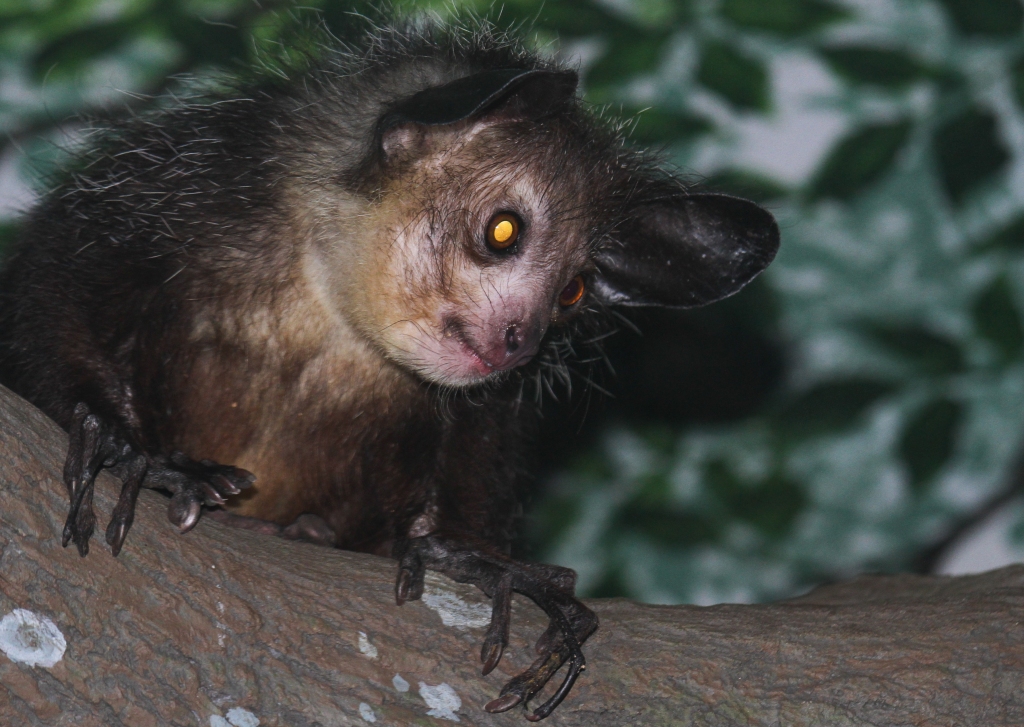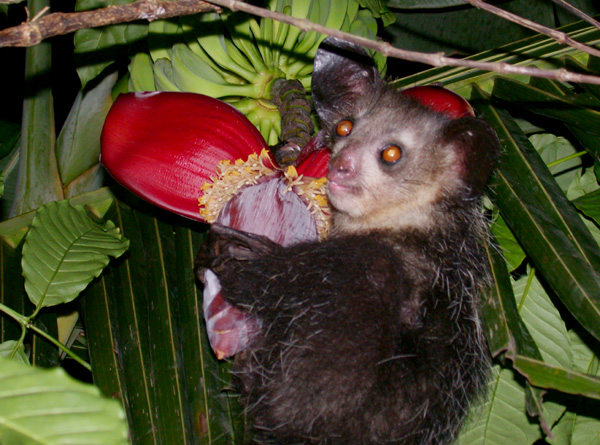Primates are known for their behavioral diversity, but perhaps no primate is as bizarre as the aye-aye (Daubentonia madagascariensis). Aye-ayes live in the eastern rainforests and northwestern dry forests of Madagascar and are the largest nocturnal (i.e., active at night) primate. In contrast to some of their lemur cousins known for striking coloration, complex social structures, and long morning choruses, aye-ayes probably fall into the category “faces only a mother could love.” Their black-grizzled fur, combined with bat-like ears, rodent-like incisors, and long middle finger, make them look quite spooky—right on time for Halloween!

Many of the aye-ayes’ distinctive physical traits help them obtain food. Aye-ayes feed on grubs (juvenile insects that live inside wood), which requires the use of their rodent-like incisors to create holes in trees. Unlike most primates, the front teeth of aye-ayes continue to grow throughout their lifetime; this is necessary as the teeth are worn down each time an individual gnaws a small hole. But how do aye-ayes know where in the wood to gnaw these holes? That’s where their long middle finger comes in. They use their spindly third finger to rapidly tap on the wood as if they are drumming. Then, they listen with their bat-like ears for echoes of their taps to locate hollow places, which is where grubs have made their homes. Once the aye-aye finds a place and opens it with its incisors, it once again uses its long finger to fish the grub out of the wood [1]. Aye-ayes also use this so-called “dip stick” technique with their middle finger to access foods such as the nectar of the iconic Ravenala tree (Ravenala madagascariensis) [2] or egg yolks [3] stolen from villages. As if an aye-aye’s hands weren’t specialized enough, scientists recently discovered that aye-ayes have a sixth digit (called a pseudothumb) which helps them regain gripping ability lost from having such a specialized third finger [4].
Even with such a striking physique, seeing a wild aye-aye is no small feat. Beyond their nocturnal lifestyle, aye-ayes are often solitary and are frequently found high in the upper layers of the canopy [2]. After emerging from their nest as night falls, aye-ayes spend approximately 80% of their night travelling and feeding [5]. Given that aye-ayes constantly move around a dark landscape, the best way to spot one is to find one of their favorite fruit trees, known locally as Ramy (Canarium sp.), when the fruit is ripe and wait for an aye-aye to arrive.
Although aye-ayes are normally solitary, they do interact occasionally. An individual aye-aye can use more than 2 km2 of forest [5]. Given that these areas in the forest can overlap, when they do encounter one another, aye-ayes communicate using several different vocalizations including contact calls and alarm calls [6]. Contact calls, which serve to help individuals keep track of each other in space, are particularly important for mother and infant duos. Aye-aye infants may travel with their mothers for longer than a year [7]—a relatively long period for a primate of their size—although the exact duration is debated due to difficulties observing juvenile aye-ayes in the wild [6].

The aye-aye is an endangered species and its populations are decline, according to the IUCN Red List. In fact, the > 100 species of lemurs make up the most threatened mammal group in the world. It is difficult to tell how many aye-ayes are left in the wild because they are rarely sighted directly [9]. Rather, researchers depend on indirect signs of aye-aye activity, such as nests or characteristic holes in trees, to document the species in the wild. Although they are endangered, aye-ayes seem to manage well in marginal habitat, such as plantations [5], since they are able to adapt their diet to include mangos, lychees, and coconuts [10]. However, this brings them into closer conflict with local human populations, who often view the aye-aye as a bearer of bad luck [11]. Like other lemurs, aye-ayes are threatened due to habitat loss [12]. The combination of the habitat loss with low population densities means that any remaining forest pockets are home to just a handful of aye-ayes each.

Although the situation may look bleak for the aye-aye and its lemur cousins, there are many conservationists, both Malagasy and from countries around the world, dedicated to protecting their habitat and working alongside local residents to learn more about their behavior. World Lemur Festival, held the last Friday each October, is a celebration of these efforts and helps to bring awareness to the issues surrounding lemur conservation. So, while the aye-aye may appear all ready to celebrate Halloween, there is more than one reason to celebrate the aye-aye each October.
Meredith Lutz is a PhD candidate in the Animal Behavior Graduate Group. She’s interested in behavioral plasticity and social behavior. Her current research focuses on drivers of social plasticity in primates and takes her to Madagascar frequently.
References
- Erickson, C. J. (1991). Percussive foraging in the aye-aye, Daubentonia madagascariensis. Animal Behaviour, 41(5), 793–801.
- Ancrenaz, M., Lackman-Ancrenaz, I., & Mundy, N. (1994). Field observations of aye-ayes (Daubentonia madagascariensis) in Madagascar. Folia Primatologica, 62(1–3), 22–36.
- Sefczek, T., Ravelonjanahary, M., & Louis, E. E. Jr. (2018). A wild aye-aye (Daubentonia madagascariensis) raids chicken eggs in eastern Madagascar. Lemur News, 21, 10–11.
- Hartstone‐Rose, A., Dickinson, E., Boettcher, M. L., & Herrel, A. (2020). A primate with a Panda’s thumb: The anatomy of the pseudothumb of Daubentonia madagascariensis. American Journal of Physical Anthropology, 171(1), 8–16.
- Randimbiharinirina, D. R., Raharivololona, B. M., Hawkins, M. T., Frasier, C. L., Culligan, R. R., Sefczek, T. M., . . . & Louis Jr, E. E. (2018). Behaviour and ecology of male aye-ayes (Daubentonia madagascariensis) in the Kianjavato classified forest, south-eastern Madagascar. Folia Primatologica, 89(2), 123–137.
- Andriamasimanana, M. (1994). Ecoethological study of free-ranging aye-ayes (Daubentonia madagascariensis) in Madagascar. Folia Primatologica, 62(1–3), 37–45.
- Petter J-J, & Peyriéras A. (1970). Nouvelle contribution a l’étude d’un lémurien malgache, le aye-aye (Daubentonia madagascariensis). Mammalia, 34, 161–193.
- Farris, Z. J., Morelli, T. L., Sefczek, T., & Wright, P. C. (2010). Comparing aye-aye (Daubentonia madagascariensis) presence and distribution between degraded and non-degraded forest within Ranomafana National Park, Madagascar. Folia Primatologica, 82(2), 94–106.
- Louis, E.E., Sefczek, T.M., Randimbiharinirina, D.R., Raharivololona, B., Rakotondrazandry, J.N., Manjary, D., Aylward, M. & Ravelomandrato, F. 2020. Daubentonia madagascariensis. The IUCN Red List of Threatened Species 2020: e.T6302A115560793. https://dx.doi.org/10.2305/IUCN.UK.2020-2.RLTS.T6302A115560793.en. Downloaded on 22 October 2020.
- Petter, J. J. (1977). The aye-aye. Primate conservation, 37–57.
- Simons, E. L., & Meyers, D. M. (2001). Folklore and beliefs about the aye-aye (Daubentonia madagascariensis). Lemur News, 6, 11–16.
- Schwitzer, C., Mittermeier, R.A., Rylands, A.B., Chiozza, F., Williamson, E.A., Byler, D., Wich, S., Humle, T., Johnson, C., Mynott, H., and McCabe, G. (eds.). 2019. Primates in Peril: The World’s 25 Most Endangered Primates 2018–2020. IUCN SSC Primate Specialist Group, International Primatological Society, Global Wildlife Conservation, and Bristol Zoological Society, Washington, DC. 130pp.
Main image: A wild aye-aye uses its spindly middle finger to access a coconut [source].
Edited by Jessica Schaefer